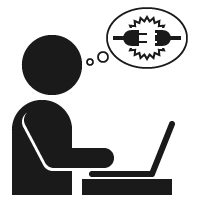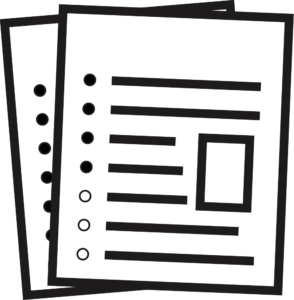Academic Rigor in the Online Classroom

In their 2011 book, Academically Adrift, Arum and Roksa claimed that academic rigor in higher education has decreased in recent years. They found that graduation and achievement have increased while time spent in the classroom and overall learning gains have decreased, thus suggesting that American higher education lacks rigor. Specifically, Arum and Roksa cite the following unfavorable statistics:
 32% of students have not needed to read more than 40 pages weekly in the current semester.
32% of students have not needed to read more than 40 pages weekly in the current semester.- 50% of students have not written more than 20 pages over the course of the current semester.
- 45% of students have not increased more than one point over two years on the 100-point Collegiate Learning Assessment; 36% of which will not show even that much improvement over four years (Arum & Roksa, 2011b).
Arum and Roksa’s results reflect an increasing concern regarding maintaining and increasing rigor in higher education, a concern that has haunted the online classroom since the late 1980s. More recently, the Council for Higher Education has identified increasing academic rigor as a foundational aspect of the future of accreditation as part of its larger mission to serve the public interest (Council for Higher Education, 2016).
However, how can instructors know if their courses are providing sufficient rigor? Is it just measuring learning gains and time spent in the classroom, as Arum and Roksa suggested? Or is there a better way to define rigor and implement the necessary strategies to achieve it? This article seeks to give a more meaningful definition of rigor and provide techniques to help instructors increase rigor in their classrooms.
Defining Academic Rigor
So, what is rigor? For a topic that is frequently discussed, it often goes undefined. Perhaps unsurprisingly, the definition depends on who you ask, as students and instructors have different definitions for what makes a course rigorous. For undergraduate students, rigor is a factor of workload, time spent, how harsh the grading is, and the level of difficulty and interest in the material (Draeger, del Prado Hill, & Mahler, 2015). In Draeger and colleagues’ (2015) study on the matter, students were less likely to identify interacting with their instructors or being pushed out of their comfort zone as relevant to their concept of rigor. Do instructors agree? The answer appears to be not quite. Instructors define rigor quite differently, placing more emphasis on instructional qualities rather than course features. In a 2013 study, Draeger and colleagues found that faculty members at one institution believed that rigor involves active learning, meaningful content, higher order thinking, and setting and meeting appropriate expectations. Although this group acknowledged that other factors may be in play and that how they are demonstrated across disciplines will vary, the faculty members ultimately concluded that the foundation of academic rigor occurs when these four dimensions are present simultaneously in the learning context.
 In 2012, Campbell and Cabrera decided to explore whether a poor understanding of rigor is what led to Arum and Roksa’s conclusions in Academically Adrift. Similar to Draeger and colleagues’ 2013 study, they concluded that deep learning occurred when higher order, integrative, and reflective thinking is required (Campbell & Cabrera, 2012). However, they also found that this relationship broke down when they compared GPA to the qualities of deep learning. This finding suggests that there is a poor relationship between the grades instructors are giving and the target of academic rigor.
In 2012, Campbell and Cabrera decided to explore whether a poor understanding of rigor is what led to Arum and Roksa’s conclusions in Academically Adrift. Similar to Draeger and colleagues’ 2013 study, they concluded that deep learning occurred when higher order, integrative, and reflective thinking is required (Campbell & Cabrera, 2012). However, they also found that this relationship broke down when they compared GPA to the qualities of deep learning. This finding suggests that there is a poor relationship between the grades instructors are giving and the target of academic rigor.
This returns us to our previous question: With this much variability in perception, how should we define rigor? Ultimately, this answer will be determined by experts in their fields and in education, but while the discussion continues via journal articles and in faculty senates, a proactive instructor can still take steps toward ensuring a rigorous experience for his or her students. The following recommendations seek to achieve this middle ground, and for our purposes, we define rigor as being present in a course when students are expected to apply their knowledge to multiple realistic contexts, monitor their own work and independently make accurate judgements on their strengths and weaknesses, and meet appropriately high expectations for meaningful achievement of the learning outcomes.
Ensuring Academic Rigor in Your Class
So how do instructors ensure that they actually provide rigor in their classes? Arum and Roksa (2011) found that writing assessments provide the best indicator of learning, which suggests that instructors can solve the disconnect between GPA and learning by including and incentivizing graded writing projects.
However, writing assignments aren’t the only way to encourage rigor and deep learning. Matusevich, O’Connor, and Hargett (2009) created a rubric for a rigorous curriculum in which they emphasized the kinds of knowledge transformation and scaffolding that writing assignments naturally draw upon. For example, to tap into some of these same principles, consult the table below.
| Feature of writing assignment | Example assignment |
|---|---|
| Require a mix of qualitatively different learning contexts. | Practice calculating with percentages by completing the odd-numbered problems in Chapter 4. Once you complete the practice items, use this approach to calculate the monthly accrued interest rate for the following investment scenarios. Summarize your findings into a recommendation: If you were planning to invest, which scenario would be better and why? |
| Build upon students’ personal interests and goals. | In this chapter, we discussed the best practices of marketing research. Imagine that you are a marketer for your favorite brand, sports team, or organization, and create a report detailing how your client should market to your classmates. |
| Require the investigation of primary materials. | Compare and contrast Narrative of the Life of Frederick Douglass, an American Slave by Frederick Douglass and Incidents in the Life of a Slave Girl by Harriet Ann Jacobs. |
| Apply critical and creative processes. | In this unit, we have reviewed how several nations address addiction through public policy. Using what you know, and researching what you don’t, create a policy that you think would be most effective in preventing addiction in your community. In your presentation, provide supporting evidence, and identify possible challenges and how you would mitigate them. |
| Encourage an open-ended learning process. | Complete a quasi-experimental research project that replicates a published study of your choice. |
However, writing assignments may not be appropriate for all courses. If you’re interested in ways you can improve rigor in your courses without a writing assignment, consider some of the following
- Create an intentional progression of learning objectives from lower to higher order thinking, with assessments aligned to each objective.
- Include at least one assessment or assignment that requires students to transform their understanding and that students cannot complete with only a comprehension of the topic.
- Design assignments to target complex ideas and concepts rather than to meet a particular time allotment.
- Set the expectation with students that they will be asked to step outside their comfort zone and incentivize work that encourages them to do so.
- Define the difference between acquiring professional skills and academic education, such as critical thinking and academic expression, with support from leadership for a balance of both.
- Include assessments or assignments that require students to reflect on their own understanding and act on any perceived strengths and weaknesses.
Conclusion
Although rigor is a topic of interest in academics today, it can be difficult to define and even more difficult to pursue if you aren’t confident about what actually promotes it in your classroom. However, based on the findings discussed in this article, academic rigor is present in courses that:
- Require students to master material with sufficient facility to apply it to multiple contexts.
- Provide students with the opportunity to develop the ability to reflect and act on their own understanding.
- Clearly set expectations and align grading and feedback opportunities to ensure students have met those expectations.
Even though students may have a different view of rigor, pushing them out of their comfort zones and into deeper learning will help them achieve their educational and career goals.
References
Arum, R., & Roksa, J. (2011). Academically adrift: Limited learning on college campuses. Chicago: The University of Chicago Press.
Arum, R., & Roksa, J. (2011b, May 14). Your so-called education. The New York Times. Retrieved from http://www.nytimes.com/2011/05/15/opinion/15arum.html
Campbell, C., & Cabrera, A. (2012). Making the mark: Are grades and deep learning related? Research in Higher Education, 55, 494–507.
Council for Higher Education. (2016, August). Talking points: The future face of accreditation: Serving the public interest. Retrieved from http://www.chea.org/userfiles/PDFs/Talking_Points_2016.pdf
Draeger, J., del Prado Hill, P., Hunter, L. R., & Mahler, R. (2013). The anatomy of academic rigor: The story of one institutional journey. Innovative Higher Education, 38, 267–279.
Draeger, J., del Prado Hill, P., & Mahler, R. (2015). Developing a student conception of academic rigor. Innovative Higher Education, 40, 215–228.
Matusevich, M., O’Connor, K., & Hargett, M. (2009). The nonnegotiables of academic rigor. Gifted Child Today, 32(4), 44–52.

 32% of students have not needed to read more than 40 pages weekly in the current semester.
32% of students have not needed to read more than 40 pages weekly in the current semester.